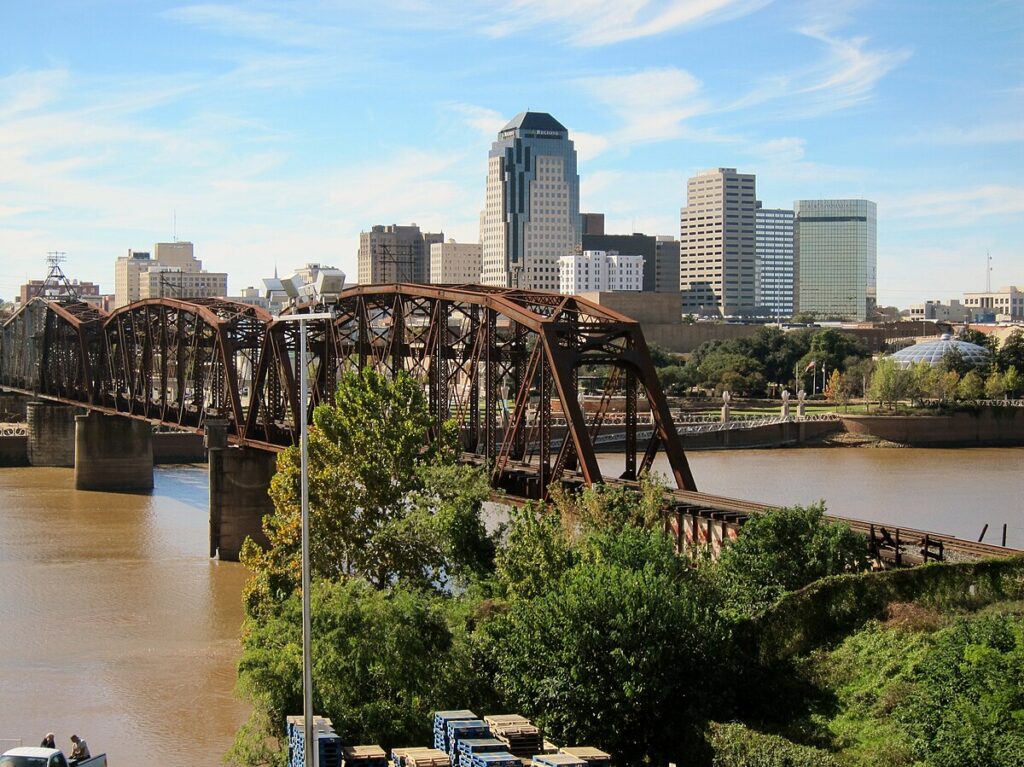
Moving to Shreveport, Louisiana: A Comprehensive Relocation Guide
Considering moving to Shreveport, Louisiana? This historic Northwest Louisiana city offers affordable living, casino entertainment, and military community. With approximately 187,000 residents in 2025 (metro 394,000+ with Bossier City), Shreveport combines Southern character with Red River beauty and Northwest Louisiana’s largest city.
Demographic Profile to Consider If Moving to Shreveport:
Shreveport’s 2025 population is approximately 187,000 residents, making it Louisiana’s third-largest city, forming a twin-city metro with Bossier City across the Red River exceeding 394,000. The median age is around 37 years, with working families, military families (Barksdale AFB nearby), diverse residents, and retirees. The population is approximately 56% Black or African American, 38% White, 4% Hispanic, 2% Asian. Shreveport features historic downtown, casino entertainment along the riverfront, diverse neighborhoods, and serves as Northwest Louisiana’s economic center. The city attracts working families seeking Louisiana affordability, military families from Barksdale, casino workers, and those wanting Northwest Louisiana regional hub. Shreveport appeals to diverse residents prioritizing affordability and regional opportunities. The community balances historic character with casino economy and military community influence. Find trusted local services for moving, living, and working in Shreveport.Shreveport Relocation Directory
Cost of Living to Consider If Moving to Shreveport:
Shreveport offers exceptional affordability. Median home values range from $140,000 to $210,000 in 2025, among Louisiana’s most affordable cities while maintaining regional hub amenities. The median household income is approximately $48,000. Rental properties average $850 to $1,200 monthly. Louisiana has no state income tax on military retirement pay; individual income tax is progressive 1.85%-4.25%. Property taxes are very low. Overall cost of living is very competitive, making Shreveport highly attractive for working families, military families, and those seeking maximum Louisiana affordability. The city provides tremendous value with casino and military employment stability. Housing costs create exceptional accessibility across diverse income levels.
Economy and Job Market:
Shreveport’s economy includes healthcare, casino gaming, military support (Barksdale AFB), and manufacturing. Major employers include Ochsner LSU Health Shreveport, Willis-Knighton Health System (major regional healthcare provider), Bally’s Shreveport Casino, Sam’s Town Casino, Eldorado Casino, General Motors truck plant, and support for nearby Barksdale Air Force Base. Healthcare dominates employment. Casino gaming provides jobs. Manufacturing offers opportunities. Typical industries include healthcare, gaming, manufacturing, and services. The economy provides regional stability though wages reflect Northwest Louisiana levels. Many residents work in healthcare, casino operations, military support, and services.
Education:
Caddo Parish School Board serves Shreveport students with numerous high schools including Captain Shreve High School, Caddo Magnet High School, and Southwood High School. School quality varies dramatically requiring extensive research with some excellent magnet schools and others struggling. Louisiana State University Shreveport offers higher education. Centenary College provides liberal arts education. The educational infrastructure serves the large, diverse population with quality varying significantly.
Recreation and Lifestyle:
Shreveport offers casino entertainment district along the Red River with Bally’s, Sam’s Town, and Eldorado providing gaming, dining, and concerts. The city features historic downtown with municipal auditorium (Louisiana Hayride legacy), R.W. Norton Art Gallery, Sci-Port Discovery Center, and Red River District entertainment. Residents enjoy cross-lake casino boulevard, diverse dining, Southern cultural heritage, community events, and immediate Bossier City access (across river). The lifestyle emphasizes affordable working-class living, casino entertainment, military community connections, and Northwest Louisiana character. The humid subtropical climate features hot summers and mild winters. The community values Southern heritage, casino economy, military family support (Barksdale nearby), affordability, and regional center status. Living in Shreveport means accepting Northwest Louisiana corner isolation, economic challenges with population decline, significant variation in neighborhood quality requiring research, some urban challenges, casino-influenced economy, and being overshadowed by Bossier City’s growth while enjoying exceptional affordability, stable casino and healthcare employment, casino entertainment, authentic Southern character, and regional hub amenities creating Northwest Louisiana’s largest city where casino economy meets Southern heritage and exceptional affordability defines the twin cities’ urban center.
Healthcare and Services:
Shreveport residents access comprehensive healthcare through Ochsner LSU Health Shreveport, Willis-Knighton Health System hospitals throughout the area, and extensive medical facilities. The concentration of hospitals serves Northwest Louisiana as the regional medical hub with quality care and medical education.
Transportation:
Shreveport is accessed via Interstate 20, Interstate 49, U.S. Route 71, and various corridors. Shreveport Regional Airport provides commercial service. SporTran operates bus service. Most residents use personal vehicles. Typical commute times within the metro are 20-35 minutes.
Conclusion:
Moving to Shreveport in 2025 offers affordable Northwest Louisiana living with casino entertainment, healthcare employment, and regional hub character. The city’s combination of exceptionally low housing costs, stable healthcare and casino jobs, and Southern culture makes it ideal for working families, military families, and those seeking Northwest Louisiana’s most affordable destination where casino economy meets healthcare stability and exceptional value defines the twin cities’ urban center.

